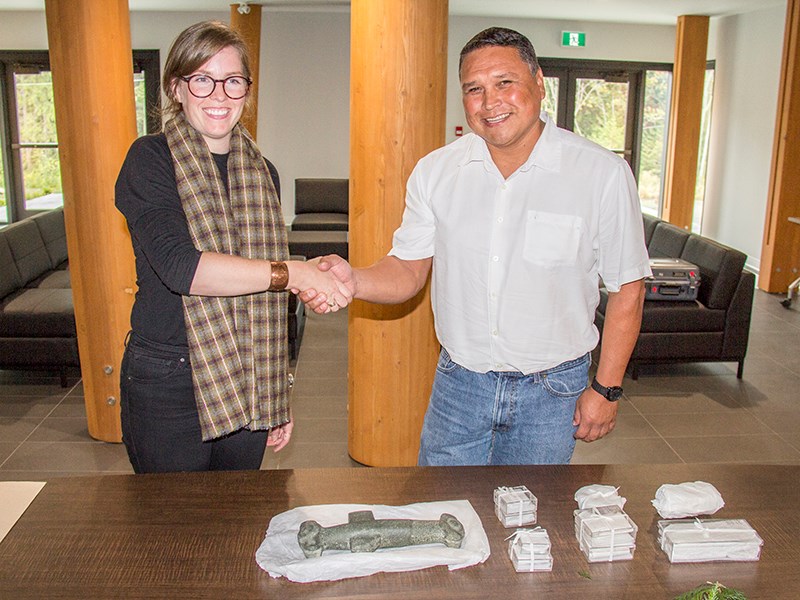Included in Tla’amin Nation’s final treaty agreement, which gave the first nation self-governance as of April 5, a small appendix on culture and heritage provides for the return of artifacts and cultural materials.
On Thursday, September 1, Royal BC Museum returned a small group of artifacts to Tla’amin.
“It’s important because this has all happened because of the self-government that is in place now,” said Tla’amin Nation hegus Clint Williams. “This is a pretty significant piece of work for anyone to achieve. Because of our self-governing status, it is possible to receive these artifacts and we want to welcome them in a good, positive way and receive them with good feeling.”
According to museum representatives, the most important piece among the returned items is a stone club.
“The stone club is a larger piece,” said Royal BC Museum curator Martha Black. “It’s carved and has a zoomorphic design on it.” Zoomorphic, said Black, refers to the carvings of animal-like heads on the club.
In some first nations along the Pacific Northwest coast, these type of clubs were often imbued with supernatural properties and played important functions in stories and establishment of traditional lands.
Williams said the pieces, particularly the club, are connected to Tla’amin traditional lands and a dark time from the past.
“It’s something to receive this because not all that long ago there was a goal to destroy and erase us from history,” said Williams. “It’s not a happy memory but we acknowledge and respect what’s still left there, because it’s powerful to see things from the past that have survived that chaotic time.”
The provenance of the club, according to Black, is approximately 1923 and five kilometres south of Powell River. It is referred to as a surface find, which means it was not discovered from archaeological excavation.
“We therefore have no information about the site or how the club was discovered,” said Black. “Carved stone clubs with the blade and shaft made as a single piece, as this one was, are rare. They are found in very small numbers from BC to Northern California and thought to be from 300 to 1,000 years old.”
According to the museum’s researcher for anthropology, Genevieve Hill, who escorted the pieces from Victoria back to Tla’amin, because the club was collected in the early days of the century, scientific methods used to date it were not in practice.
“We don’t have as much information about the date of the club as we would like,” said Hill.
In addition to the club, other artifacts returned include trading beads, a hand-maul fragment, numerous stone flakes, worked glass, bone point, disc-shaped stone with central hole, or spindle whorl, and disc-shaped stone with perforated centre.
Based on the treaty agreement, some Tla’amin artifacts will be held by the museum, such as trading beads, baskets, slate knives, slate and stone points and blades.
According to Hill, more Tla’amin artifacts certainly exist that have not been recovered. She said more archaeological exploration is required and more excavation, care and attention to the existence of sites.
“[Tla’amin] are concerned and they care, and we need the rest of the community to care as much as they do about their heritage,” she said.
That care and concern underlies a bigger issue for Tla’amin people regarding their cultural heritage, according to Williams. He said many unrecorded archaeological sites exist throughout the traditional territory, including sacred places and artifacts that have been desecrated, including ancient burial sites.
“Some of these burials were done in wooden boxes,” said Williams. “Someone used one of these burial boxes as kindling to start a fire. That was somebody’s burial site, who knows, hundreds or thousands of years ago, and it’s disrespected and we don’t like that. It doesn’t matter what your race, religion or anything is, nobody likes to have their ancestors remains destroyed.”



